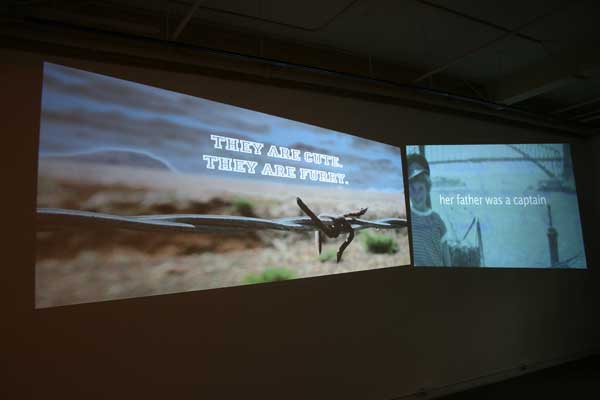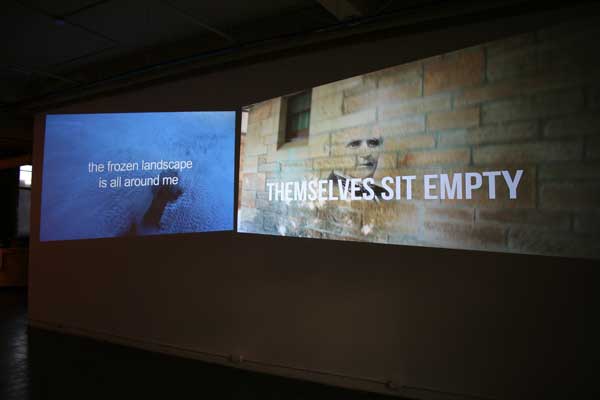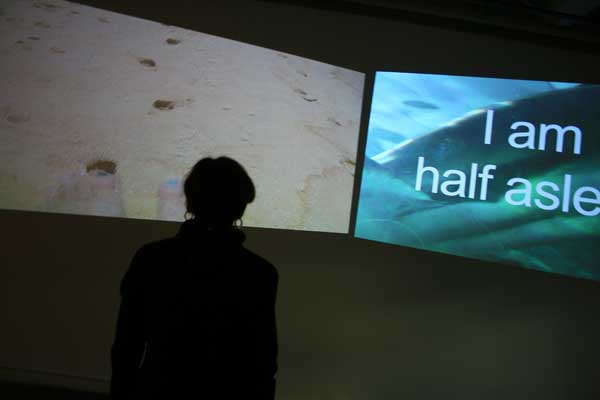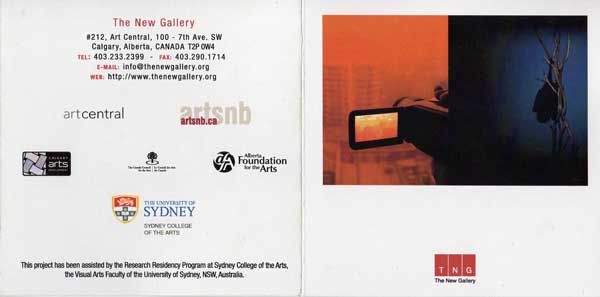What We Take With Us – TNG (2012)



We just came back from Calgary where our video installation What We Take With Us is being presented at The New Gallery. The opening was on January 5th and the exhibition will continue until February 4th 2012. We stayed at the John Snow House which is administrated by TNG. It is an extraordinary place loaded with history.
Thanks to everyone at TNG: Tim, Jessica, Noel, Kathryn, Su, Volunteers – and all who came out to the opening! Our talks will be posted online next week.
Our installation is also part of This Is My City Festival, an interdisciplinary festival of art from the margins.
Excerpt from the essay written by Tomas Jonsson:
Recurrent waves of colonialism and globalization have smoothed and prescribed our encounters with places. For the traveler, points of difference, or of distinction, are sought after, perhaps increasingly so, or patronizingly handed over. Monuments, historical sites and natural landmarks are increasingly oriented to ‘the amused eye’, which the traveler can then compare and develop a discourse “for the comparative connoisseurship of places.”
In What We Take With Us, Dugas and LeBlanc explore a complicated, contingent terrain, whose borders extend into and circumvent geographies, both physical and social, ‘here’ and ‘away’. Encompassing individual catalysts, personal experiences, mental and body memories, the resulting landscape can’t be easily anticipated or defined.
The videos mimic the internal ordering and filtering of places. Each series of vignettes display a personal vision, reflecting the difference in interpretation even by two people so closely aligned. They follow in Dugas and LeBlanc’s collaborative approach in their production and presentation, but in this case the associations are left to chance due to an unsynched running time. The result is a constantly shifting dialogue between the videos, with unknown permutations and combinations.
Camille, Andrew, Katrina & Co, an essay By Tomas Jonsson (2010)
NECESSARY FICTIONS
Tomas Jonsson
There is a quote by Steve Rienke, the source for which I couldn’t find when I wrote this, that goes something like this: “Critical reviews often rely on an autobiographical experience to instill a personal connection to the work in question, a strategy operating with a mistaken assumption that this imbues the review with meaningful insight.” Implied in his criticism of subjective criticism is that it mistakes the object under interrogation. The suggestion is that critical writing should be more about the art object than about a personal experience of a work of art. Irecognize that I am often guilty of this, and after reading Rienke, I have made an effort -not always successfully- to adopt other strategies.
It is true that inserting oneself within the fabric of a critical response can be too easy a strategy, and often runs the risk of being less interesting than the work under discussion. Sometimes, however, the act of viewing is a subject of the work, and, when one viewer sees multiple works he or she is at the hub of a complex web of associations and judgments. Such is the case in my viewing of Nelson Henrick’s Failure, (2007, 7:00 minutes) and Daniel Dugas’ Camille, Andrew, Katrina and Co. (2008, 109 minutes). These two videos were screened at two distinct occasions as part of EMMEDIA’s CRASH! Narrative Explorations series. Beyond their obvious relation to the larger programming theme, something in the works sparked my curiosity, a sense that these works could speak to each other, that their respective strategies and explorations could offer some shared insight; a simultaneous push and pull at the borders of the conventions, and their personal identities that they worked with, and within. Both also implicate the viewer in the act of viewing, and challenge -subtly and overtly- passive reception of what we are witnessing.
Subtitled “self portrait 61,” Nelson Henrick’s Failure suggests an exhaustive interrogation of the artist. If the previous 60 video portraits (and perhaps more that follow) exist, this is the only one so far to surface for public presentation. It begins with Henricks lying on the floor while a melancholic piano from a Nina Simone song plays. In several shot cuts we then see him peeking out from over a kitchen counter and table, and then lying on the bed. The screen goes black before we hear him sigh and say ‘I think that is ok.” A conscious slip of editing that begins to trouble our acceptance of what we are receiving. In the second segment of this video, we see Henricks shaving, first his beard and then his legs, while the following subtitles play out:
Insert subtitles in this section
Text refers to events in adolescence
That inspired the action onscreen
But not in an obvious way
Keep it open-ended and ambiguous
Make the titles go on long enough
To preserve the integrity of the long take
Keep the performative gesture unedited
While also distracting the spectator
From their boredom
Or find another strategy
Like go to a cut-away
The subtitles reflect the actions on screen. We are left to imagine our own interpretation of the adolescent acts hinted at in this ritual (or why, for that matter, Henricks shaves his legs with his pants still around his ankles).
Following the scripted cut away of scene two (a long holding shot of the humming razor) the view shifts to a record player, and the needle positioned to a fragment of a Serge Gainsborough song, where a woman’s voice lustfully and repeatedly whispers ‘nelson’, the needle is lifted immediately following her third and last utterance of the –his- name. In the next scene, Henricks emerges awkwardly from behind a curtain in a photo studio and performs an equally awkward shuffle to a tune by Pavement. “Special Guest star” Benoit Chasse appears with a handwritten sign that reads “impoverished aesthetics”. A few very rapid cuts follow, in tune to the skipping of the audio track. Despite what this audio tic immediately suggests, none of this is accidental, but rather carefully constructed. These cuts offer a fleeting glimpse of Henricks engaged in the production of this work (setting up lights, etc.), before we return to see him again lying melancholic on the floor as the Nina Simone song plays out, extending into the credits.
Failure is coated with a thick ironic sheen. It reads like a challenge, offering a seductive possibility of inference while at the same time mocking any attempt at reading insight to Henricks’ exploration of identity, and any presumed failures, try as we might. How and where do we attribute failure? Is the performative ritual of shaving symbolic of the inferred adolescent events; a failure to align with gender conventions? We can’t confirm the readings as true regarding the subject outside of the video, but that does not prevent us from wanting – wishing – to know something of him through this construction.
Daniel Dugas’ Camille Andrew, Katrina and Co. exists in several formats, including a website, publication and script. The DVD version is presented in eight chapters and features optional English subtitles that mirrors the French voice that both informs us what we are seeing and provides all the character voices. At times, the visual narrative does not align with the verbal / textual description, and the results are jarring. It is as if the camera cannot keep up with the direction, or instead pursues its own aesthetic concerns. The imagery has a dream-like quality which plays out at a slow, relaxed pace, even during scenes of violent conflict or struggle.
The story follows the conventions of a crime scene drama— immediately familiar to anyone with a steady diet of televised crime shows like CSI—with some magic realism thrown in for good measure. The video employs continuous foreshadowing of the events to come, and cliffhanger endings to the episodic chapters. At times, it seems that the narrator has ambitions that cannot be realized by the constraints of the hand-held video and foley sound. There is a subtle irony to this voice-over; we don’t quite believe it. It takes us in and out of the story, reminding us that we are watching a construction. Perhaps this is a screen test for a later, more realized version.
There are a few stylistic flourishes, such as when we are drawn in to regard a painting of a ship in a storm. The camera moves into focus on one figure who, the narrator informs us, notices us, and who then begins to move up, floating or flying into the oncoming storm. The painting is in the house of Ted, who we come to recognize as the protagonist. He is cooking eggs in the kitchen of his 1970s bungalow (we are told). Over time, we come to learn more about him: his job at an insurance company; the convention he is to give a speech at; as well as larger, sinister forces that he will soon contend with as the (fore)shadow of an upcoming hurricane approaches.
We are only presented the characters in fragments. Dugas does double and triple service performing many of the characters, distinguishable only by their clothing or through representation of their actions. A conversation between Ted and his wife Suzie, for example, is only represented by their respective cups of coffee.
At the end credits, footage taken from houses destroyed from the real hurricane Katrina play out, and we are reminded this is not merely content fodder for a dramatic thriller. In the real world there were no industrious children (Ted’s son, Teddy and his friends) that saved New Orleans, and it is safe to assume that a convention of hurricanes did not plot out the damage to descend on this city. Thinking back on this piece, what can we take from this story and bring towards an understanding of the real events?
Both videos are self-conscious about the conventions of video; neither hide the construction of their form and content. Any engagement we might feel is continually subverted by our awareness of the external frames. These videos are performances. It means something that we recognize the role the artists play in this construction. In my search for the elusive quote by Steve Reinke, I did find this one, which makes this point plain:
“Through video, figures that were previously just functions of the text can be physically embodied in ways that radically undermine the stability of authors in relation to their texts and narrators. Video artists can be positioned both interiorly and exteriorly (behind and in front of the camera) to their texts in a way that is impossible for writers, who must always, despite all their desperate efforts to the contrary, remain off-page.”1
Reading this, I was reminded of watching Adaptation, a movie that, like these two videos, exposes filmic and narrative convention even as it follows it. In the climatic finale -an absurd battle between the protagonist, played by Nicholas Cage and a crocodile- induced hysterical laughter from myself and my friend, to the annoyance of others in the theatre who were more willing to go along with the story.2
As Reinke notes, video is more amenable to this kind of slippage. It can create a space where the real and the fiction can co-exist in a tense ambivalence that destabilizes the comfort of suspended belief. While these two works subvert the conventions of conventional filmic narrative, this subversion does not counteract but rather gives new life to tired, often meaningless, conventions. Through this tension we shift from passive viewers to active participants in the construction.
Of course, this terrain is well covered. I’m conscious that a comparative analysis of two works could be made of any number of tapes, and is in itself perhaps a banal strategy. With this risk in mind, these works, exposed to me over time and space, nevertheless instill in me a nagging thought that results in an impulse to translate this to print.
________________________________________________________________
1. Nelson Henricks’ Failure was screening on November 25th, 2010 along with Deborah Stratman’s O’er the Land. Daniel Dugas’ Camille Andrew, Katrina and Co. was screened on May 14, 2010
2. I would like to thank Donna Wawzonek for reminding me of this incident.
Download the full version of IMPACT STATEMENTS
© 2010 EMMEDIA Gallery & Production Society
All Rights Reserved
All rights reserved. No part of this publication
may be reproduced or transmitted in any form
without prior written permission from the publisher.
Library and Archiving Canada
Cataloguing in Publication
IMPACT STATEMENTS:
CRASH! Anthology of Critical Texts
ISBN 978-0-9737962-9-2
Published by
emPRESS
EMMEDIA Gallery & Production Society
#203, 351 – 11 Ave SW
Calgary, AB
Canada T2R 0C7
1-403-263-2833
www.emmedia.ca
Edited by David Garneau
Project managed by Tomas Jonsson
Design by Vicki Chau
Printed in Canada by Emerson Clarke Printing
Daniel H. Dugas
Archives
Blogroll
- A.I.R. Vallauris
- ACAD
- Adobe additional services
- Adobe Creative Cloud
- AIRIE
- Amaas
- Amazon Author Central
- ARTothèque
- Australian Poetry
- Basic Bruegel
- Bitly
- CCCA
- CDBaby
- Cycling 74
- Dissolution
- Éditions Prise de parole
- Emmedia
- eyelevelgallery
- FAVA
- Festival acadien de poésie
- Festival FRYE Festival
- FILE – Electronic Language International Festival
- Freeware list
- Fringe Online
- Galerie Sans Nom
- Gotta Minute Film Festival
- Instants Vidéo
- JUiCYHEADS
- Kindle Direct Publishing
- Klondike Institute of Art and Culture
- La Maison de la poésie de Montréal
- La Maison de la Poésie et de la Langue française Wallonie-Bruxelles
- Laboratorio Arte-Alameda
- Le Centre Jacques Cartier
- Liberated Words
- Maison Internationale de la Poésie – Arthur Haulot
- MediaPackBoard
- Miami Book Fair International
- Monoskop
- Mot Dit
- NSCAD University
- Paved Arts
- PoetryFilm
- Portail des auteurs du Nouveau-Brunswick
- RECF
- Revue Ancrages
- Salon du Livre du Grand Sudbury
- Sculpture Space
- Subtropics.org
- Sydney college for the arts
- The Centre for Contemporary Canadian Art
- The New Gallery
- Trevigliopoesia
- tumbler-documents
- V Tape
- Valerie LeBlanc
- VideoBardo
- Void Network-Κενο Δίκτυο
Categories
- #covidpoèmes
- Advertisement
- AIRIE
- Ancrages
- anthology
- Anthropocene
- Architecture
- Around Osprey
- art
- Article de presse
- arts visuels
- audio
- Australian Poetry
- Basic Bruegel Editions
- Book
- book fair
- Cafe Poet Program
- Ce qu'on emporte avec nous
- Citations gratuites
- Collaboration
- commentaire
- commentary
- Compte rendu
- conférence
- Conservation Foundation of the Gulf Coast
- COVID-19
- Critique littéraire
- culture
- Daniel Dugas
- Design
- Édition Michel-Henri
- Éditions Perce-Neige
- Éloizes
- Emmedia
- emoji etc | émoji etc
- Environnement
- essai
- essay
- Everglades
- Exhibition
- festival
- Festival acadien de poésie
- Festival Frye Festival
- FIPTR
- Flow: Big Waters
- Fundy
- Habitat
- installation
- Instants Vidéo
- interactivity
- journal
- JUiCYHEADS
- Kisii
- L'Esprit du temps
- laptop
- Leaving São Paulo
- lecture
- Livre
- logos
- Magazine
- Miami Book Fair
- Moncton 24
- novel
- OASIS
- oil spill
- perception
- performance
- Photo
- poésie
- Poetic Licence Week
- Poetry
- politics
- politique
- press
- Prise de parole
- Revue Ancrages
- salon du livre
- sculpture
- Sculpture Space
- sound
- Souvenirs
- Spirit of the Time
- Style & Artifacts
- Symposium d'art/nature
- talk
- television
- The New Gallery
- Uncategorized
- Valerie LeBlanc
- vidéo
- vidéopoésie
- Videopoetr/Vidéopoésie
- videopoetry
- visual arts
- What We Take With Us
- youth literature









